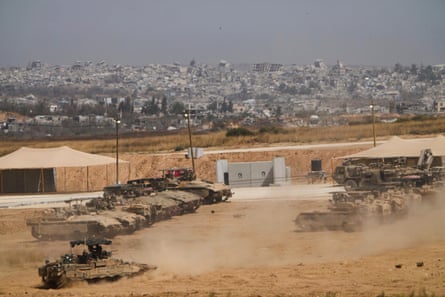A global military buildup poses an existential threat to climate goals, according to researchers who say the rearmament planned by Nato alone could increase greenhouse gas emissions by almost 200m tonnes a year.
With the world embroiled in the highest number of armed conflicts since the second world war, countries have embarked on military spending sprees, collectively totalling a record $2.46tn in 2023.
For every dollar invested in new hardware, there is not only a corresponding carbon cost but also an opportunity cost to potential climate action, critics say. This is on top of the huge death toll resulting from armed conflicts.
“There is a real concern around the way that we are prioritising short-term security and sacrificing long-term security,” said Ellie Kinney, a researcher with the Conflict and Environment Observatory and a co-author of the study, shared exclusively with the Guardian.
“Because of this kind of lack-of-informed approach that we’re taking, you’re investing in hard military security now, increasing global emissions for that reason, and worsening the climate crisis further down the line.”
That in turn is only likely to lead to further violence, with climate change itself now increasingly seen as a driver of conflict, albeit indirectly. In Sudan’s Darfur region, conflict was linked to competition over scarce resources after prolonged droughts and desertification. In the Arctic, receding sea ice is leading to tensions over who should control newly accessible oil, gas and critical mineral resources.

Few militaries are transparent about the scale of their fossil fuel use, but researchers have estimated that collectively they are already responsible for 5.5% of global greenhouse gas emissions.
That figure is expected to rise as tensions escalate in a number of regions and as the US, for decades the world’s biggest military spender, indicates that it expects its Nato allies to devote significantly more resources to their armed forces.
According to the Global Peace Index, militarisation increased in 108 countries in 2023. With 92 countries involved in armed conflict, in places ranging from Ukraine and Gaza to South Sudan and DRC, with tensions seething between China and the US over Taiwan, and with the frozen conflict between India and Pakistan flaring, governments fearful of war are investing heavily in their militaries.
In Europe, the increase has been particularly dramatic: between 2021 and 2024, EU states’ weapons spending rose by more than 30%, according to the International Institute for Economics and Peace.
In March, the EU, disconcerted by Donald Trump’s cutting of military aid and diplomatic support for Ukraine, indicated this would go further, with proposals for a further €800bn spend across the bloc outlined in a plan called “ReArm Europe”.
In analysis for the UN Office for Disarmament Affairs, Kinney and colleagues looked at the potential impact of increased militarisation on meeting climate goals. What they found was sobering: the likely increase in emissions from Nato’s remilitarisation alone would be the equivalent of adding the cost of a country as large and populous as Pakistan to the world’s remaining carbon budget.
“Our analysis specifically looks at the impact on sustainable development goal 13, which is climate action – to take urgent action to combat climate change and its impacts,” Kinney said. “And what our analysis finds, looking at the various sub-targets of that … [is] that there is a real threat to global climate action caused by global increase in military spending.”
Of all functions of states, militaries are almost uniquely carbon-intensive. “First of all, with the equipment that they purchase, which is mainly a lot of steel and aluminium, which is very carbon-intensive to produce,” said Lennard de Klerk, of the Initiative on the GHG Accounting of War, another co-author of the study.
“Secondly is during operations, armies are very mobile. And in order to move around they use fossil fuels – that’s diesel for ground operations and kerosene for air operations. Or for maritime operations it’s mainly diesel as well, if they’re not nuclear-driven.”
Given the secrecy that usually surrounds militaries and their operations, it is difficult to know just how much greenhouse gases they are emitting. Only Nato countries report enough of their emissions for scientists to attempt an estimate.
after newsletter promotion
“We took Nato because they are the most transparent in terms of spending. So it’s not that we particularly want to focus on Nato, but simply because they have more data available,” De Klerk said.
The researchers calculated by how much greenhouse gas emissions would increase if Nato countries excluding the US – since it already spends far more than the others – made a two percentage point increase in the share of GDP they devoted to their militaries.
Such an increase is already under way, with many countries in Europe significantly increasing military spending in response to the crisis in Ukraine. Although Nato countries have publicly committed to increasing spending to 2% of GDP, the researchers say the ReArm Europe plan could lead to an eventual rise to 3.5%, from about 1.5% in 2020. The researchers assumed a similar eventual increase in Nato members that are not members of the EU, such as the UK.
Borrowing methodology from a recent paper that argued each percentage point increase in the share of GDP devoted to military spending would lead to an increase in national emissions of between 0.9% and 2%, they estimated that a two percentage point spending shock would lead to an increase across the bloc of between 87 and 194 megatonnes of carbon dioxide equivalent (CO2e) a year.
The researchers say that not only would such a huge increase in emissions supercharge climate breakdown but the increase in global temperatures would hurt the economy. Recent estimates of the social cost of carbon – a monetary indicator of the damage of CO2 emitted – put it at $1,347/tCO2e, suggesting the annual cost of Nato’s military buildup could be as much as $264bn a year.
And that is only a fraction of the true carbon cost of militarisation, Kinney points out. “The calculation in the paper, it’s 31 countries – that only represents 9% of total world emissions. If you consider … the impact of that, there’s a lot of the world that we haven’t taken into consideration of this specific calculation.”
The analysis notes that spending more money on militaries also reduces resources available for policies aimed at mitigating climate change. This already seems to be the case, with the UK, for example, funding its increase in spending by reducing its overseas aid budget – a move mirrored in Belgium, France and the Netherlands.
“This increase in military spending is impacting the kind of core trust that is necessary for multilateralism,” Kinney said. “At Cop29, global south countries like Cuba in particular pointed out the hypocrisy in the room of states being willing to spend increasing amounts on their military spending, but offering … completely, unacceptably low climate finance commitments.”
The Guardian has contacted Nato for comment.

 3 months ago
58
3 months ago
58

















































